|
|
Post by Liteway on Feb 1, 2014 19:18:42 GMT -5
I've been pretty well satisfied with the functionality of my trike for some time now. Not so with the way it looks. Needs more attitude. Here is what I have in mind. Seating position has already been lowered and reclined by building a new seat. Saved 23 lbs too. Cowling will be moved back 6 inches. A cut down plexi wraparound windscreen will be installed, provided I can get it bent correctly. These changes will provide a more fully inclosed kockpit and make an already effective heating provision more so. Also should mean less drag. Contrary to drawing, door will be installed on the left side, where the framing already provides for a cutout. No frame changes will be necessary. By moving the tag to the rear fender, I can use a smaller lower head fairing. Painting will be minimal as I plan on polishing the major aluminum panels with just accents in bright colors or flat black, inspired by late war P51s. Should go well with the dozens of exposed pop rivets. Whadayall think DS-1 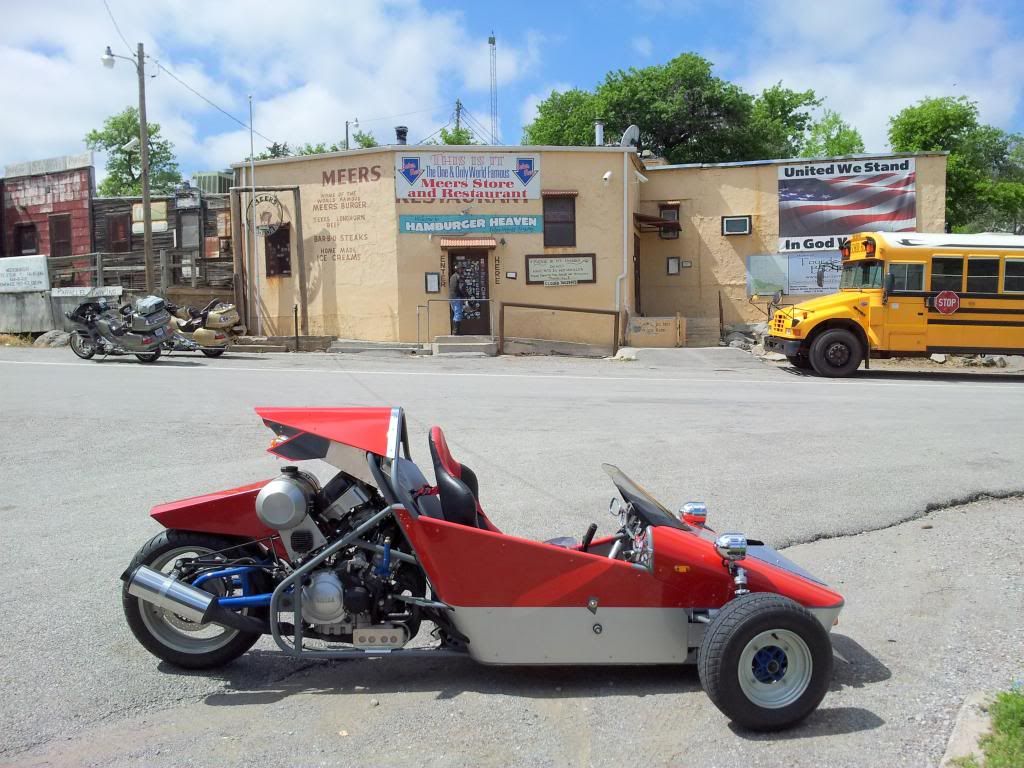
Projected
 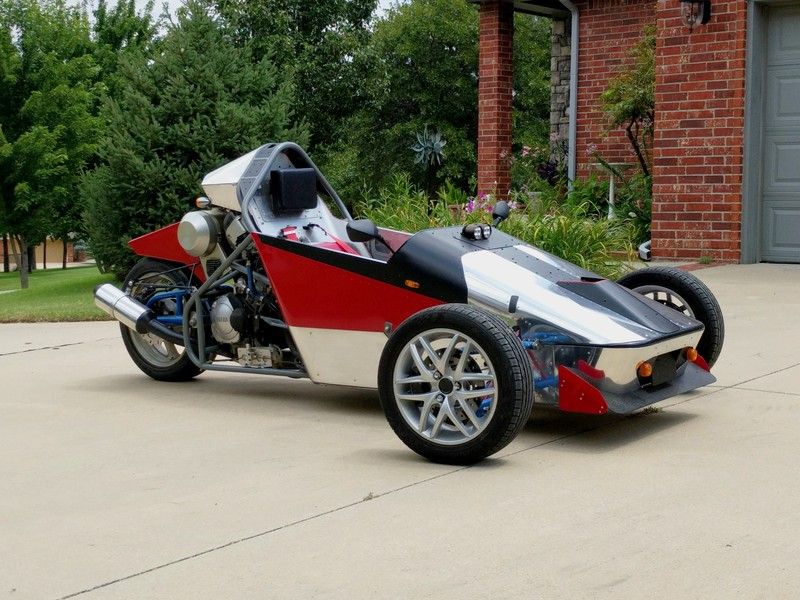 DS-2 completed 06/06/17 |
|
|
|
Post by stretchmobileski on Feb 2, 2014 0:07:54 GMT -5
I like the changes. The head fairing change is the best. Moving the headlights back also? Go for it.
|
|
|
|
Post by DaveJ98092 on Feb 2, 2014 0:46:24 GMT -5
I too think the change will look nice but the trike looks OK now too. Getting more out of the elements is one of my "Top of the list" things. You got too much time on your hands, being retired and such.  Man, I'll have my points in 18 months. |
|
|
|
Post by stretchmobileski on Feb 2, 2014 14:07:06 GMT -5
I retire end of June, 26 years with the county. I am going right back to work as shop foreman for my friend who owns a company that makes lapidary equipment. I get to learn CNC machining, wear whatever I want and get free powder coating.
|
|
|
|
Post by Liteway on Feb 3, 2014 12:20:54 GMT -5
You guys are going to love retirement. I highly recommend it. Thanks for encouragement. Did not need much to order the metal. Just for fun here is a somewhat half baked alternative I considered. 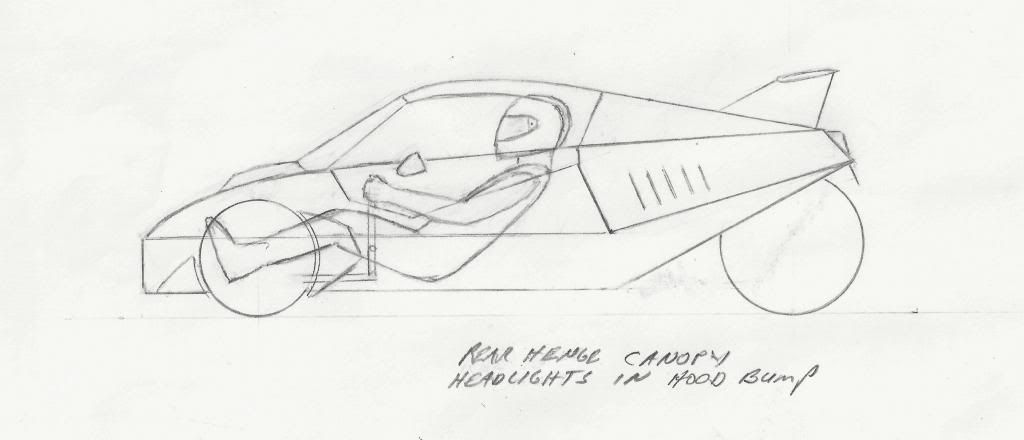 Top could henge from the right side as well. Windshield could be permanently attached to either body or roof. Side windows optional. Problems? No room in the current chassis to stretch out like this and still have room for a decent seat. This would be fairly accurate display of driver orientation in the first drawing also, but with an extra 8 or 9 degrees of rake in the seating position in the second drawing.( begin edit 2/7) Also, top pic allows 2.5 or 3" under drivers butt for frame rails, seat and padding. Bottom pic would have butt against frame rails. If seated this low there would not be enough room below drivers lower legs to clear steering bell cranks located there, so packaging really does not work. Like I said "half baked". Reality bites, fantasy more fun. Too bad. Under 40" overall height would finally bring front wheels into correct proportion to the rest of the body.(end Edit.) It may look like there is not enough room in the nose for pedal assemblies, radiator, brake master cylinders, etc. , but I have already proven the packaging with the current trike. Would require fiberglass work for top and hood panels. My fiberglass skills are zero. Aside from those, all other panels have no compound curves and could easily be bent up out of aluminum. Getting the top stiff enough to be mostly flex free and open and close properly would be tough. Don't like the idea of looking through plexiglass all the time, especially at the angle of this windshield. Could never get safety glass in shape/size necessary. It would be heavy and require a heavy support structure. However, in this form the cowl would not have to be moved back and the windshield could be derived from a 3/16" Goldwing unit with just a bit of cutting at the edges. If I were up to it, (big if) the reduction in drag would create a whole new performance envelope. It would be great if someone with more skills , willing to start from scratch, would pick up on the idea. |
|
|
|
Post by stretchmobileski on Feb 3, 2014 18:01:46 GMT -5
You can have any windshield cut down. Tape off the area you want and sand blast the edge away. Works with safety glass, just go to the junkyard and find the right curve. Fiberglass isn't hard, messy yes but not hard. Look at a few you tube videos. Go to a plastic supply store in your area and they can set you up with all the tools (not many really.) Keep lots of acetone for clean up. If you have a roof, you most likely don't need a helmet.
|
|
|
|
Post by Liteway on Feb 4, 2014 1:25:12 GMT -5
Valid points, but I have looked at fiberglassing how-tos on the internet. Anybody can make stuff with it, but a lot of the results are not what I could live with. Even so I should keep an open mind, do some experimenting. Make a scoop or something.
Looks nasty and labor intensive to work with.
Bought a practice kit from Aircraft Spruce 5 years ago. Still sitting on a shelf.
Limited shelf life?.
Anyway, the kit and instructions are for foam core construction. This produces light stiff panels with no need for buck or mold. Finished panels are too bulky for my use, but can be used structurally, not just a skin. Good example is a surf board.
|
|
|
|
Post by Liteway on Feb 5, 2014 15:54:56 GMT -5
Spent the first couple of months in retirement renovating my shop, Mostly to be able to regulate air temp and quality. My tools and workspace were already confined to one corner of the 24X28 garage so that all three vehicles could always be stored overnight. Problem was heating cooling the whole space. It could take an hour or two to get the space comfortable with my window unit and by then I would be distracted by something else and never get started in the shop. So I enclosed my little 10X14 corner. Now it can made comfortable in a few minutes no matter how hot or cold outside.
Deleted all shop pics 9/25/16
|
|
|
|
Post by 1983JZR3W on Feb 5, 2014 16:33:41 GMT -5
Very nice set up!! You do nice work and should be very proud.
|
|
|
|
Post by Liteway on Feb 8, 2014 11:12:50 GMT -5
Thanks Z06lite. Ordered project metal a couple of days ago. First thing to do was change out the seat. Nothing wrong with the old seat, that is, if you were using it in a Mustang. It was simply out of scale in my trike. Kind of like a Lazyboy in a shifter cart. Heavy too. Seat and rails were 38lbs. That is 7 percent of total vehicle weight. New seat and head rest weighs 13 lbs, weight savings equal to adding 4hp. The rest of redesign would not work with old seat, so this was a necessary first step. I could not find a production seat to meet my needs. Right height, weight, rake, width and vinyl covered. Also side bolstering could not be too aggressive as it would limit elbow room when using the side sticks. So I made one. Every thing but the cushion covers which I had done professionally. Downside New seat is not quite as comfortable as the old one, but close. Due to lack of side bolsters, I now have to depend on the 4 pt belts to keep me planted in quick maneuvers. Shell is .080 alu. sheet bent on all sides. Shell had 1/8" pad glued to it, over that vinyl was glued on.  Working out padding scheme before going to upholsterer. 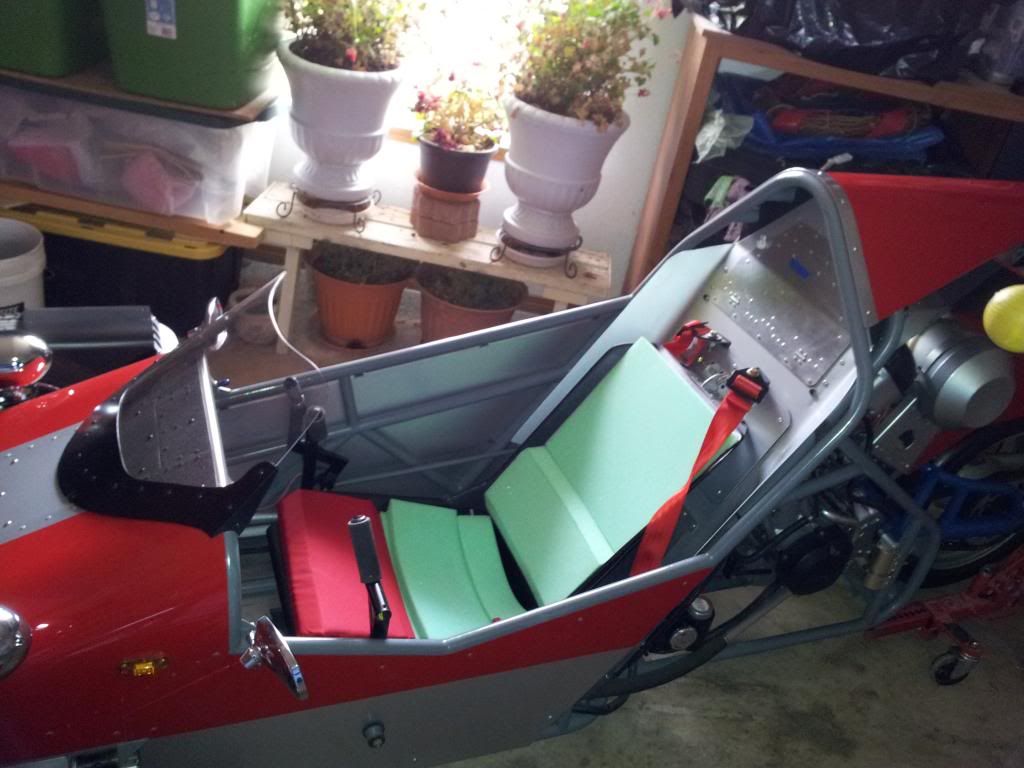 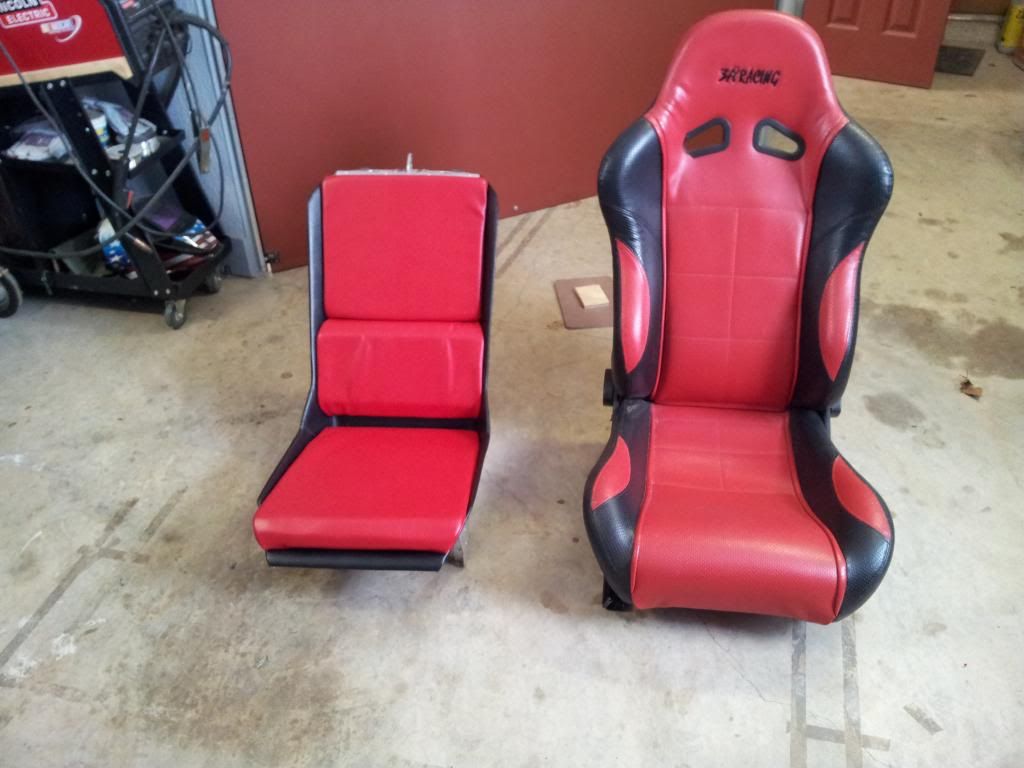 Bolt latch holds at the back. When released seat can tilt forward on front pivot mounts. remove wing nut, slide seat sideways 3/4" and seat comes out. You don't need to take the belts out first. Old seat was 45min aggravation to remove and reinstall. 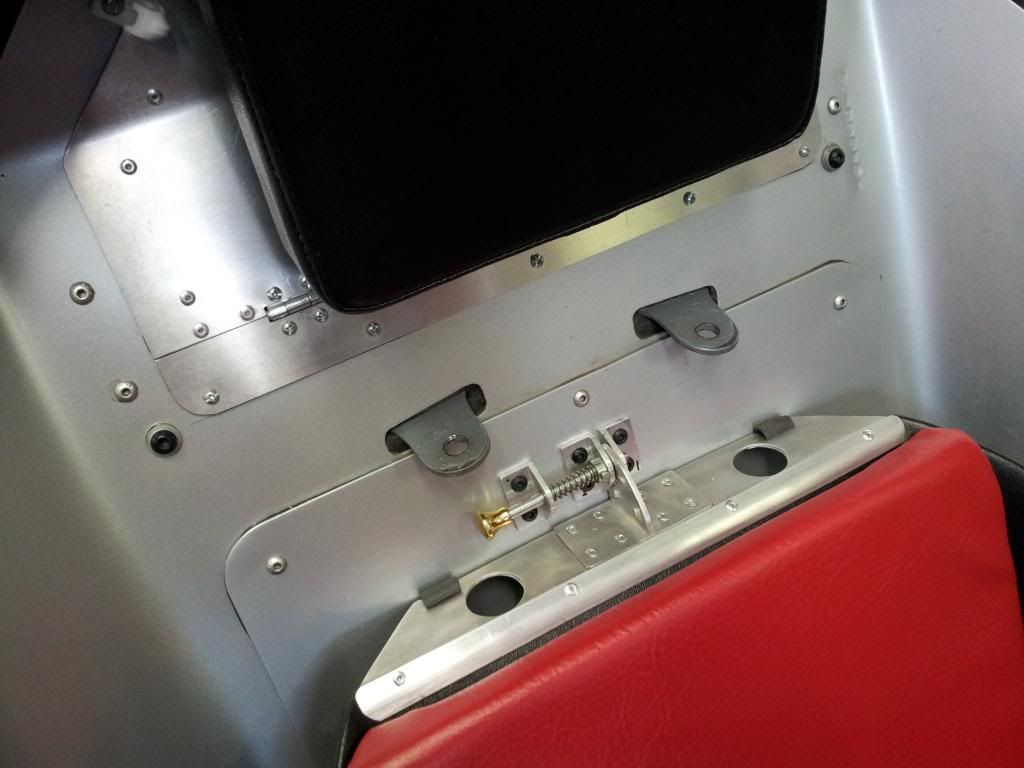 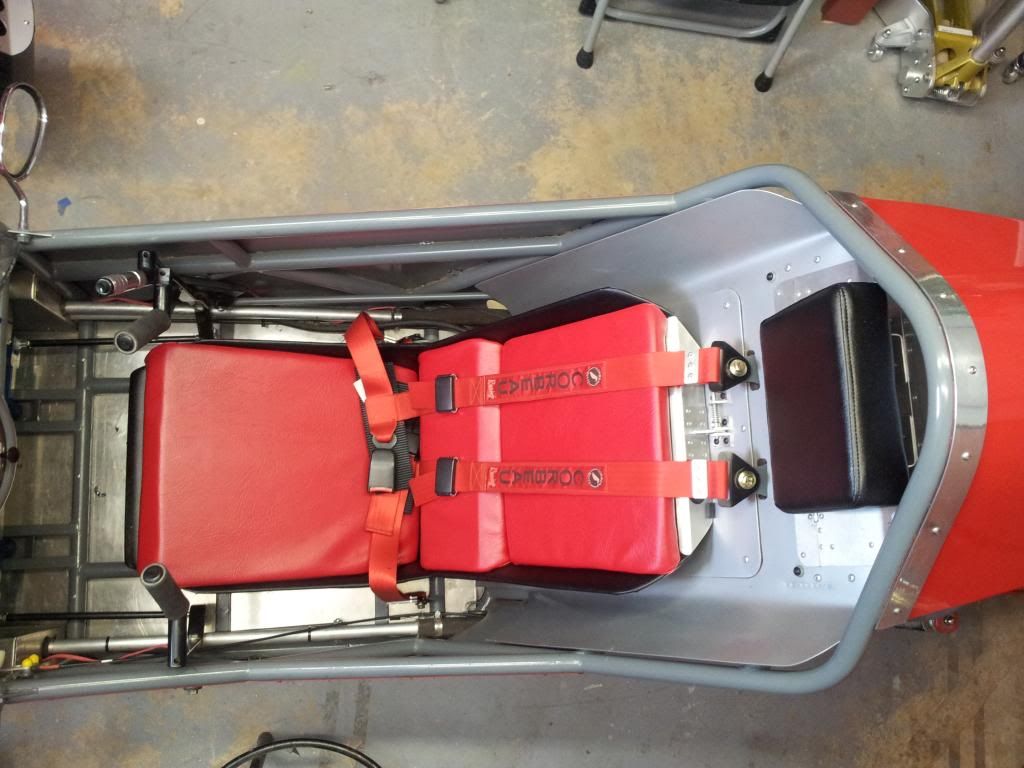 |
|
|
|
Post by Thatguy on Feb 8, 2014 12:47:41 GMT -5
Nice seat design, That "racing" car seat was really the only thing that detracted from your overall design IMO. You really should go for your body design concept, It would definitely set your RT apart from the crowd, how many enclosed RT designs that are home-built do you see? Not many.
|
|
|
|
Post by Liteway on Feb 13, 2014 10:35:14 GMT -5
Thanks for your interest. I think I addressed problems with putting a roof on this trike in the caption to the second drawing. Yeah, I like the idea of an enclosed trike also. But; The reason you see so few enclosed trikes is its very difficult to pull off. Building a fully enclosed body and making it work is nearly as difficult as building a chassis and calls for a separate set of skills. If you can build a fully enclosed trike and make it right, you could probably build an enclosed light aircraft. As low as my trike is, with its high side frame rails, the roof would have to open up to allow entry. How to get out if a wreck leaves you upside down? This trike was never intended as a daily driver, but a weekend toy. The additional weather coverage provided by the makeover and the existing kokpit heating system will allow comfortable use anytime except when its raining. I have already had to fudge a bit on the intended redesign. The exiiting double roll bar hoop does not allow me to fit the head fairing as drawn. I had thought I might cut the rear side off and brace the front. Now that I have it stripped it, I am not inclined to do so. I'll just attach the fairing to back bar instead. 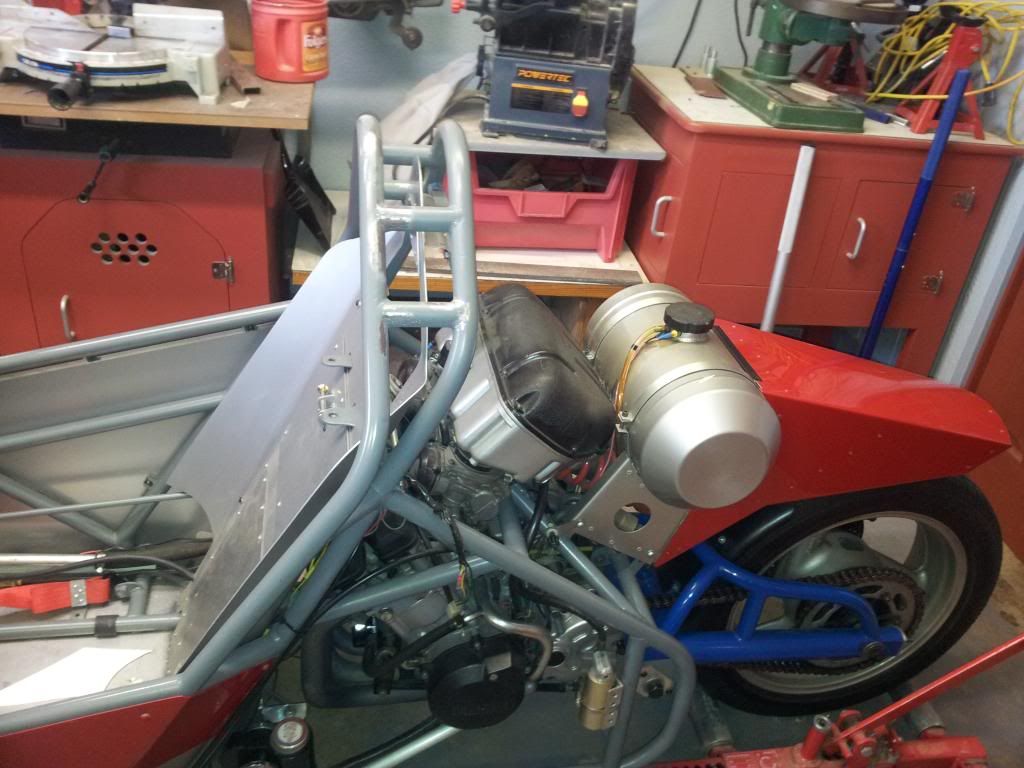 |
|
|
|
Post by DaveJ98092 on Feb 13, 2014 11:57:40 GMT -5
I noticed you have what looks like a Lincoln 155 amp wire feed MIG. Does it make good pipe/tube joints? I have the Lincoln SP155 220 volt Mig and use 75/25 mix. It has done well in all things I do except thin stock. For light car body type welding I liked my older SP120 110 volt MIG but my son burnt it up not paying attention to the duty cycle and welding up on E-10 setting for hours. I had asked him to wait till I got my new 220 volt one but alas..... Sure I would love a $2200 Miller Millermatic 212  |
|
|
|
Post by Liteway on Feb 13, 2014 13:28:27 GMT -5
Its a 135. I have joined tube from .035 to .095 with no problems. Never tried sheet. I think I'm using 75/25 but its been years since I filled the bottle, so Maybe. I want a tig for working Aluminum.
Theoretically it can done be with this one. I bought the alum wire , feed liner, and co2 bottle, but newer got satisfactory results.
|
|
|
|
Post by stretchmobileski on Feb 13, 2014 16:15:21 GMT -5
I noticed you have what looks like a Lincoln 155 amp wire feed MIG. Does it make good pipe/tube joints? I have the Lincoln SP155 220 volt Mig and use 75/25 mix. It has done well in all things I do except thin stock. For light car body type welding I liked my older SP120 110 volt MIG but my son burnt it up not paying attention to the duty cycle and welding up on E-10 setting for hours. I had asked him to wait till I got my new 220 volt one but alas..... Sure I would love a $2200 Miller Millermatic 212  What size wire are you running? For sheet metal and thin tubing (exhaust) try .023. For general welding .030 and heavy gauge use .035. The thinner wire requires less amperage to melt and you can weld thin metal without blowing holes. Usually requires different feed rollers and maybe sheath. Aluminum works best with a spool gun. It doesn't push through long housings well. You also need 100% argon or helium with aluminum for best weld. |
|
|
|
Post by Liteway on Feb 13, 2014 16:35:39 GMT -5
I noticed you have what looks like a Lincoln 155 amp wire feed MIG. Does it make good pipe/tube joints? I have the Lincoln SP155 220 volt Mig and use 75/25 mix. It has done well in all things I do except thin stock. For light car body type welding I liked my older SP120 110 volt MIG but my son burnt it up not paying attention to the duty cycle and welding up on E-10 setting for hours. I had asked him to wait till I got my new 220 volt one but alas..... Sure I would love a $2200 Miller Millermatic 212  What size wire are you running? For sheet metal and thin tubing (exhaust) try .023. For general welding .030 and heavy gauge use .035. The thinner wire requires less amperage to melt and you can weld thin metal without blowing holes. Usually requires different feed rollers and maybe sheath. Aluminum works best with a spool gun. It doesn't push through long housings well. You also need 100% argon or helium with aluminum for best weld. Right, Its been awhile since I tried the alu. welding and was using argon, not co2 as I said previously. Also probably right about the spool feed though I have never tried it. You must very careful to keep your housing straight or get a dreadful jam even with a purpose made lining. |
|
|
|
Post by mtntech on Feb 13, 2014 21:26:45 GMT -5
IMO, your trike would really benefit from an upgrade in the front wheel and tire department.
|
|
|
|
Post by stretchmobileski on Feb 13, 2014 23:04:52 GMT -5
What size wire are you running? For sheet metal and thin tubing (exhaust) try .023. For general welding .030 and heavy gauge use .035. The thinner wire requires less amperage to melt and you can weld thin metal without blowing holes. Usually requires different feed rollers and maybe sheath. Aluminum works best with a spool gun. It doesn't push through long housings well. You also need 100% argon or helium with aluminum for best weld. Right, Its been awhile since I tried the alu. welding and was using argon, not co2 as I said previously. Also probably right about the spool feed though I have never tried it. You must very careful to keep your housing straight or get a dreadful jam even with a purpose made lining. I've had several sets of aluminum wheels narrowed by Eric Vaughn. I was surprised that he uses a MIG welder to weld the wheels. He has a motorized plate he bolts the wheel to after he machines the pieces. The plate is vertical and spins slowly. He has a MIG gun mounted on the side. He turns on the motor for the wheel which spins it real slowly just like it was on a car. Hits the switch for the gun and it welds beautifully. I would have swore he used TIG. It can be done but takes a lot of practice and experience. |
|
|
|
Post by Liteway on Feb 13, 2014 23:15:12 GMT -5
Nice workmanship on your trike! Just curious, do your panels rattle from vibration as you drive? The short answer is yes, probably. Initially I ran a thin bead of of silicone calk between the frame tubes and the large flat side panels that I thought most likely to drum or buzz. In the course of making mods, those bonds were broken long ago. The engine is extremely loud with the induction about 1ft from my ears. The exhaust, cam chain, clutch, are all much more noticeable than on a bike because you are so close and down on the same level as the engine. During rapid acceleration the noise is unbelievable . I always wear ear plugs and usually a helmet. If the panels are buzzing I cannot hear them. (Edit 2/14) At steady highway cruising speeds its no louder than a bike with a decent muffler. Wind noise predominates. Most panels are attached with button head screws at a dozen or so points (no dzus). I think that helps. |
|
|
|
Post by Liteway on Feb 14, 2014 0:17:16 GMT -5
IMO, your trike would really benefit from an upgrade in the front wheel and tire department. I don't think so. Larger wheels and tires [edit 2/16( I assume that is what you mean by "upgrade") end edit] mean higher unsprung and total weight. More frontal area. More rotational mass (flywheel effect) for those tiny disc brakes to deal with. Bigger brakes? Need to change out the hubs and now we are talking whole new front end. There is plenty of adhesion for braking and the cornering power is limited by inside wheel lifting, not sliding. The current tires are speed rated to 130 and operating with a fraction of their maximum load rating on them. There is no practical reason to do it unless the whole front end is upscaled with a wider track for more absolute cornering power. Not even sure that marginal gain would be worth trading the extra maneuverability, agility, afforded by a my current 54" track. For perspective , that is 1/2 ft wider than the early super sevens,18 inches narrower than a T-rex. Would look a lot better though. |
|